The COUNTIFS function, how to use the cell count function according to multiple events in Excel
The COUNTIFS function in Excel is used to count cells but satisfy the given conditions. The COUNTIFS function is one of the more commonly used Excel functions in Excel, which is the advanced function of the COUNTIF function that only counts cells with a given condition. When done with the COUNTIFS function, users can easily find the result cell that satisfies the conditions specified in the request. Conditions can be numbers, dates, text or cells containing data. The following article will guide you how to use the COUNTIFS function in Excel.
- How to compare data on 2 Excel columns
- Using the DSUM function to calculate the sum with complex conditions in Excel
- How to use the SUMIF function for conditional summing in Excel
- VLOOKUP function to use and specific examples
Instructions for using COUNTIFS function in Excel
COUNTIFS function syntax is = COUNTIFS (criteria_range1, criteria1, [criteria_range2, criteria2], .) .
Inside:
- Criteria_range1 is the first selection that requires statistics and required values.
- Criteria1 is a condition that applies to criteria_range1 selection, the required value can be cell, expression, text.
- [criteria_range2, criteria2] are selections and additional conditions, which allow up to 127 selection pairs and conditions.
Note when using the COUNTIFS function:
- Additional selections need to have the same number of rows and columns with the criteria_range1 area, which can be separated.
- If the selection condition refers to an empty cell, the COUNTIFS function automatically evaluates to 0.
- Can the characters be used? To replace certain characters, the * symbol replaces an entire string. If you need to find the sign? or a true *, then type ~ in front of that character.
1. Data sheet No. 1
We have the data table below to make some requests for the table.
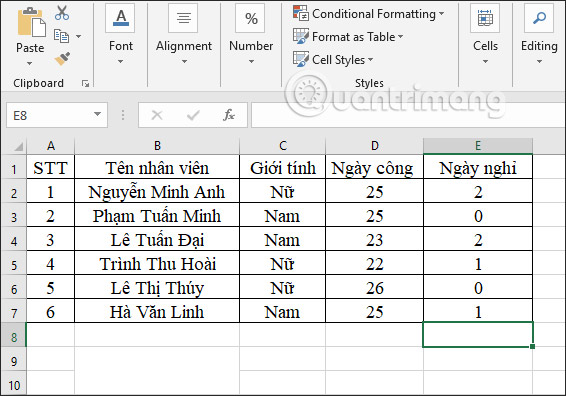
Example 1: Calculate the number of male employees with 25 working days.
In the field to enter the result, enter the formula = COUNTIFS (C2: C7, "Male", D2: D7,25) and press Enter.
Inside:
- C2: C7 is the area of counting 1 required for gender of employees.
- Male is the condition of the count area 1.
- C2: C7 is the counting area 2 with the Employee's Day.
- 25 is the condition of the count area 2.
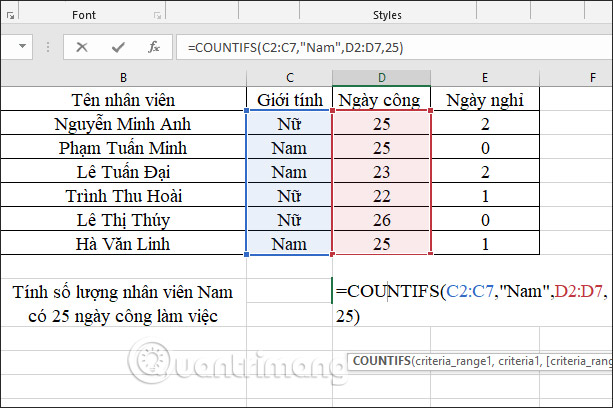
As a result, we have 2 employees, Nam who has 25 man days.
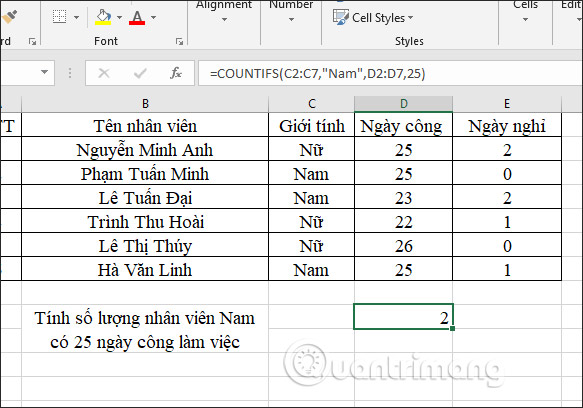
Example 2: Calculate the number of male employees whose holidays are 0.
In the formula input box, enter = COUNTIFS (C2: C7, "Male", E2: E7,0) and press Enter.
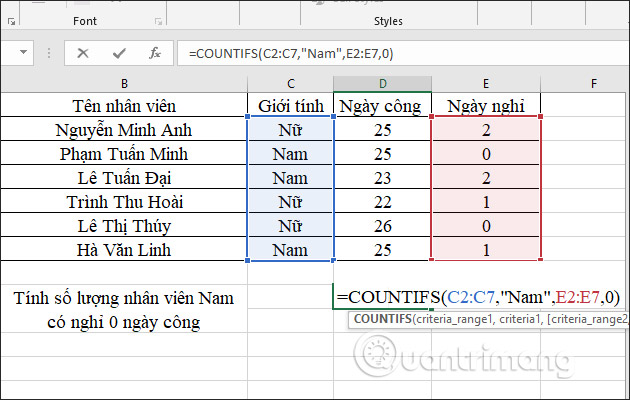
Results show 1 male employee has 0 holidays.
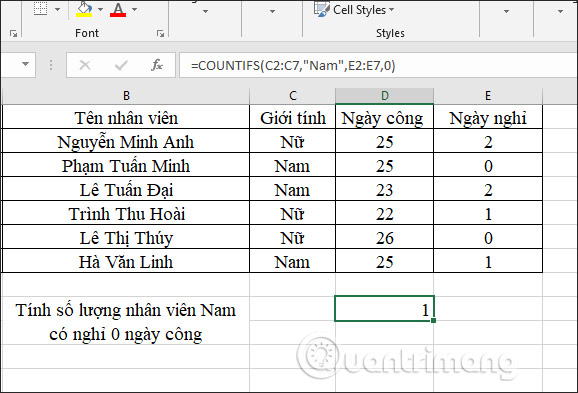
Example 3: Calculating the number of male employees with a 25-day workday and having less than or equal to 2 days of leave.
We enter the formula = COUNTIFS (C2: C7, "Male", D2: D7,25, E2: E7, "<= 2") and press Enter.
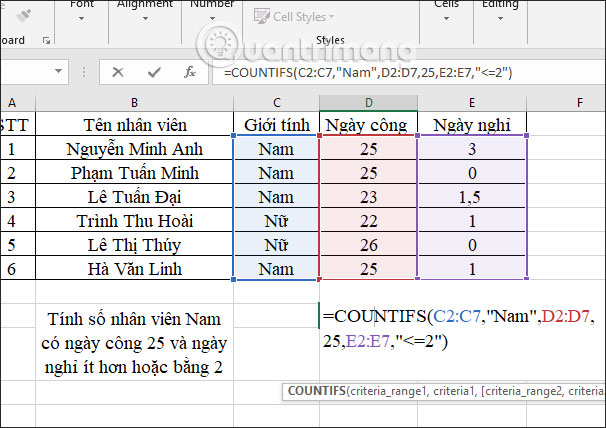
The result is that 2 male employees who meet the requirements have a holiday of less than or equal to 2 days.
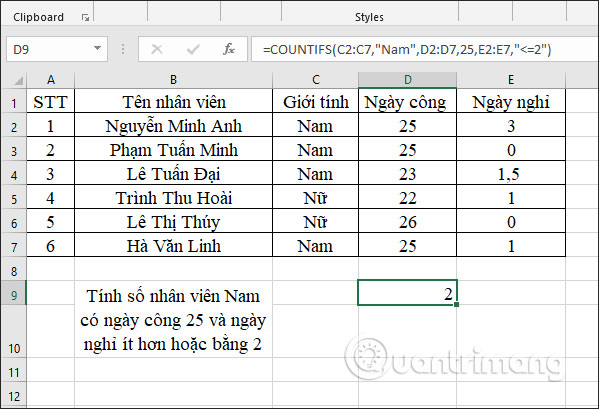
2. Data sheet no.2
Example 1: Calculate the total of Taiwanese goods with a selling price under 200,000 VND.
In the input box, enter the formula = COUNTIFS (B2: B7, "* Taiwan", C2: C7, "<200,000") and press Enter.
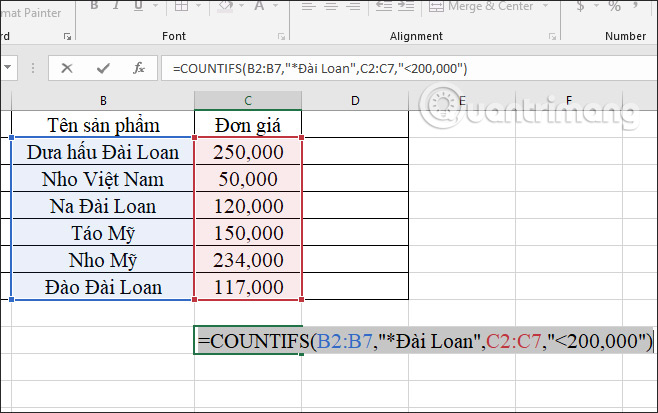
The result is 2 Taiwanese products in accordance with the requirements.
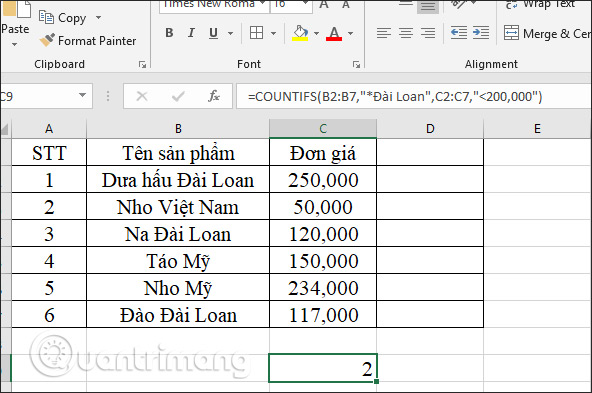
Example 2: Calculate the total product of Taiwanese products with a unit price of between VND 100,000 and VND 150,000.
At the input box, enter the formula = COUNTIFS (B2: B7, "* Taiwan", C2: C7, "> 100000", C2: C7, "<150000") and then press Enter.
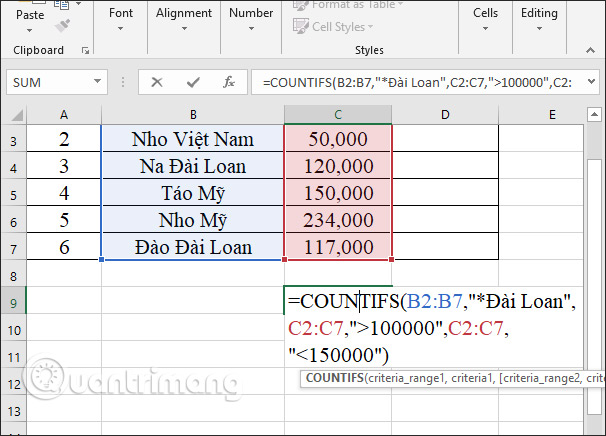
As a result, two Taiwanese products will be priced between VND 100,000 and VND 150,000.

Above are 2 data tables with usage for COUNTIFS function in Excel. The user must write the condition that comes with the conditional data area so that the COUNTIFS function determines correctly.
I wish you all success!
You should read it
- COUNTIFS function - The function performs counting the number of cells in a data table that satisfy many conditions in Excel
- Basic Excel functions that anyone must know
- DCOUNTA function, how to use the function to count non-empty cells in Excel
- Instructions on how to count words in cells in Excel
- How to use the LEN function in Excel
- How to use the COUNT function in Excel
- The COUNTA function, how to use the function to count cells containing data in Excel
- How to count characters in Excel
May be interested
- How to Count Characters in Excel on PC or Mac
 this wikihow teaches you how to find the number of characters in a cell or group of cells using microsoft excel. open the spreadsheet that contains the characters you want to count.
this wikihow teaches you how to find the number of characters in a cell or group of cells using microsoft excel. open the spreadsheet that contains the characters you want to count. - COUNTIFS function - The function performs counting the number of cells in a data table that satisfy many conditions in Excel
 countifs function: the function performs counting the number of cells in a data table that satisfy many conditions. syntax: countifs (criteria_range1, criteria1, [criteria_range2, criteria2], ...)
countifs function: the function performs counting the number of cells in a data table that satisfy many conditions. syntax: countifs (criteria_range1, criteria1, [criteria_range2, criteria2], ...) - Basic Excel functions that anyone must know
 the basic functions in excel such as the excel function, the excel statistics function we summarized below will be very helpful for you who often have to work on excel spreadsheets, especially in the field of accounting. let's refer to offline.
the basic functions in excel such as the excel function, the excel statistics function we summarized below will be very helpful for you who often have to work on excel spreadsheets, especially in the field of accounting. let's refer to offline. - How to use the LEN function in Excel
 the len function in excel is used to measure the length of a certain string of characters, including spaces and correctly return the total character for the user.
the len function in excel is used to measure the length of a certain string of characters, including spaces and correctly return the total character for the user. - CELL function to look up information of a cell in Excel
 cell () returns the format, position, or content information of a cell depending on your needs. when you need to look up a cell's information, cell () is the most used function.
cell () returns the format, position, or content information of a cell depending on your needs. when you need to look up a cell's information, cell () is the most used function. - The COUNTA function, how to use the function to count cells containing data in Excel
 the counta function in excel counts the number of cells containing data, non-empty cells in excel.
the counta function in excel counts the number of cells containing data, non-empty cells in excel. - COUNT function - Function that counts cells containing numbers in the list of arguments in Excel
 count function: the function performs counting cells containing numbers in the list of arguments. syntax: count (value1, [value2], ...)
count function: the function performs counting cells containing numbers in the list of arguments. syntax: count (value1, [value2], ...) - How to use ADDRESS function in Excel
 the address function in excel takes the number of rows and column numbers as arguments and returns the reference of the standard cell (cell address). for example, if you go to row 4 and column 3, the function returns c4.
the address function in excel takes the number of rows and column numbers as arguments and returns the reference of the standard cell (cell address). for example, if you go to row 4 and column 3, the function returns c4. - ISFORMULA function - The function returns True if that cell refers to a cell containing a formula in Excel
 isformula function: the function returns true if that cell refers to a cell containing the formula. support functions from excel 2013 onwards. syntax: isformula (reference)
isformula function: the function returns true if that cell refers to a cell containing the formula. support functions from excel 2013 onwards. syntax: isformula (reference) - COUNTA function in Excel, function to count cells containing data with specific usage and examples
 the counta function in excel is a useful data statistics function. below are details on how to use the function to count cells with data in excel.
the counta function in excel is a useful data statistics function. below are details on how to use the function to count cells with data in excel.










 Need an alternative Google Suite solution? This is why you should use Zoho
Need an alternative Google Suite solution? This is why you should use Zoho DCOUNTA function, how to use the function to count non-empty cells in Excel
DCOUNTA function, how to use the function to count non-empty cells in Excel The SUMIFS function, how to use multiple conditional calculation functions in Excel
The SUMIFS function, how to use multiple conditional calculation functions in Excel Differentiate between SUM, SUMIF, SUMIFS and DSUM functions
Differentiate between SUM, SUMIF, SUMIFS and DSUM functions Instructions for writing vertical letters in Word
Instructions for writing vertical letters in Word How to compare two documents in Google Docs
How to compare two documents in Google Docs